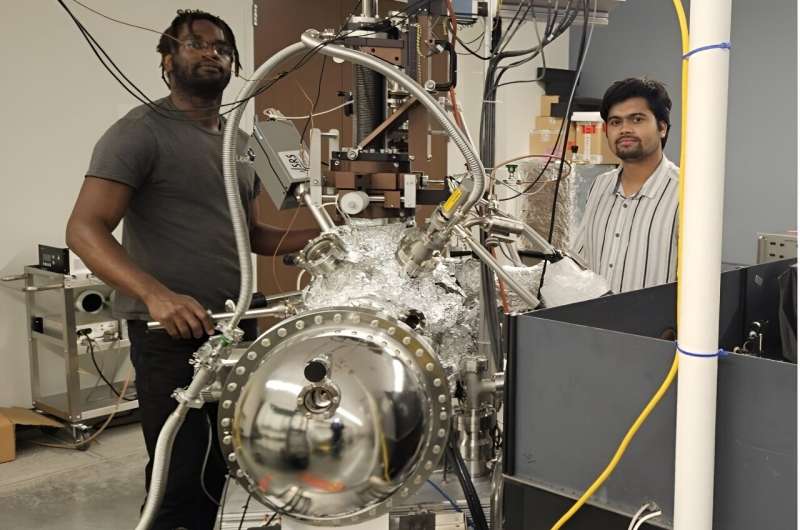
Lead author Kushal Rijal (right) and Neno Fuller (left) performed the TR-TPPE measurement using the ultrahigh vacuum photoemission spectroscopy system shown in the photo. Credit: Kushal and Fuller
Solar energy is essential for a clean energy future. Traditionally, solar energy is harvested using silicon, the same semiconductor material used in common electronics. But silicon solar panels have drawbacks: for example, they are expensive and difficult to mount on curved surfaces.
To address these problems, researchers have developed alternative materials for solar energy harvesting. Among the most promising are so-called “organic” semiconductors, carbon-based semiconductors that are abundant on Earth, cheaper, and environmentally friendly.
“They can potentially reduce the cost of producing solar panels because these materials can be applied to arbitrary surfaces using solution-based methods, much like we paint a wall,” said Wai-Lun Chan, associate professor of physics and astronomy at the University of Kansas.
“These organic materials can be tuned to absorb light at selected wavelengths, which can be used to create transparent solar panels or panels of different colors. These characteristics make organic solar panels particularly suitable for use in next-generation green and sustainable buildings.”
Organic semiconductors are already used in display panels for consumer electronics such as mobile phones, televisions and virtual reality headsets, but they are not yet widely used in commercial solar panels. One of the shortcomings of organic solar cells is their low efficiency in converting light into electricity, about 12% compared to monocrystalline silicon solar cells which have an efficiency of 25%.
According to Chan, electrons in organic semiconductors typically bind to their positive counterparts called “holes.” In this way, light absorbed by organic semiconductors often produces electrically neutral quasiparticles called “excitons.”
But the recent development of a new class of organic semiconductors, non-fullerene acceptors (NFAs), has changed the game. Organic solar cells made with NFAs can achieve efficiencies close to 20%.
Despite their exceptional performance, the scientific community still does not understand why this new class of NFA significantly outperforms other organic semiconductors.
In a groundbreaking study published in Advanced materialsChan and his team, including graduate students Kushal Rijal (lead author), Neno Fuller and Fatimah Rudayni in the Department of Physics and Astronomy, and in collaboration with Cindy Berrie, a professor of chemistry at KU, have discovered a microscopic mechanism that partly addresses the exceptional performance achieved by an NFA.
The key to the discovery was measurements made by lead author Rijal using an experimental technique called time-resolved two-photon photoemission spectroscopy, or TR-TPPE. This method allowed the team to track the energy of excited electrons with subpicosecond time resolution (less than a billionth of a second).
“In these measurements, Kushal (Rijal) observed that some of the optically excited electrons in the AFN can gain energy from the environment instead of losing energy to the environment,” Chan said. “This observation is counterintuitive because excited electrons typically lose their energy to the environment like a hot cup of coffee loses its heat to the environment.”
The team believes that this unusual process occurs at the microscopic scale thanks to the quantum behavior of electrons, which allows an excited electron to appear on multiple molecules simultaneously. This quantum oddity is consistent with the second law of thermodynamics, which states that any physical process leads to an increase in total entropy (often called “disorder”) to produce this unusual energy-gaining process.
“In most cases, a hot object transfers heat to its cold surroundings because heat transfer results in an increase in total entropy,” Rijal explains. “But we found that for organic molecules arranged in a specific nanoscale structure, the typical direction of heat flow is reversed so that the total entropy increases. This reversed heat flow allows neutral excitons to gain heat from the surroundings and dissociate into a pair of positive and negative charges. These free charges can in turn produce electric current.”
Based on their experimental results, the team suggests that this entropy-driven charge separation mechanism enables organic solar cells made with NFAs to achieve much higher efficiency.
“Understanding the underlying charge separation mechanism will allow researchers to design new nanostructures that exploit entropy to direct the flow of heat, or energy, at the nanoscale,” Rijal said. “Although entropy is a well-known concept in physics and chemistry, it has rarely been actively used to improve the performance of energy conversion devices.”
Additionally, the KU team believes that the mechanism discovered in this work can be used to produce more efficient solar cells, but they also believe it can help researchers design more efficient photocatalysts for the production of solar fuel, a photochemical process that uses sunlight to convert carbon dioxide into organic fuels.
More information:
Kushal Rijal et al., Endothermic charge separation occurs spontaneously in non-fullerene acceptor/polymer bulk heterojunction, Advanced materials (2024). DOI: 10.1002/adma.202400578
Provided by the University of Kansas
Quote:Promising solar energy material gets curious boost from entropy, researchers show (2024, July 10) Retrieved July 11, 2024 from https://techxplore.com/news/2024-07-material-solar-energy-curious-boost.html
This document is subject to copyright. Apart from any fair dealing for the purpose of private study or research, no part may be reproduced without written permission. The content is provided for informational purposes only.